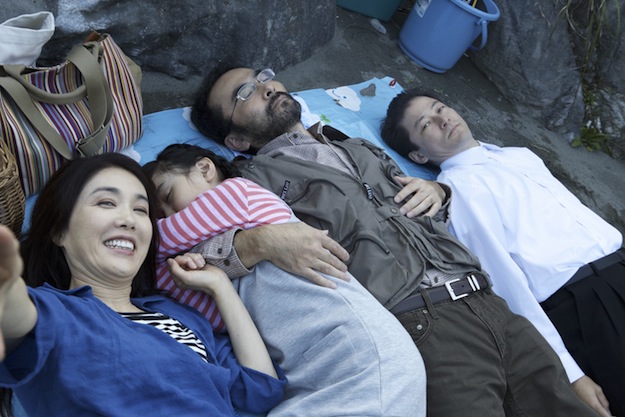Cannes Interview: Kôji Fukada
Winner of the Prix du Jury in Un Certain Regard at this year’s Cannes, Harmonium observes a family as it’s dealt a tragic blow and then no less shaken by the process of recovery. Toshio (Kanji Furutachi) runs a garage workshop that opens right into the home he shares with his wife, Akié (Mariko Tsutsui), and their cute-as-a-button daughter, Hotaru (Momone Shinokawa). Trouble arrives when Toshio hires Yasaka (Tadanobu Asano), a friend with an unsavory past who’s in need of a break—though the complicated effects of his arrival on the close-knit family are best left unrevealed. FILM COMMENT spoke briefly with director Kôji Fukada (Hospitalité, 10), just a few days before he accepted his award at the UCR ceremony with an effusive speech one might not expect based on his new film’s fragile reserve.

What was the inspiration for the story?
To be honest, I wrote the one-page synopsis for the film about 10 years ago, so I don’t remember what inspired me to write it. But there are two things that I wanted to explore in this project, and the first one is family. Through the depiction of a family, a married couple or parent and child, I wanted to explore solitude—the essential, fundamental solitude that we all possess as individual human beings as part of the human condition. The second thing I wanted to explore was this sense of violence that can happen to any of us and disrupt our daily lives.
Do you think of Harmonium as a tragedy, in a classical sense?
It is a classical tragedy, in the sense of Greek tragedy and all the tragic stories throughout history that have been told repeatedly. You could say that they all offer points of view on life, and in that sense I think the film falls into that category as well.
The setting you choose is quite fruitful cinematically, because the family’s lives—their work lives and their home lives—are tied up together. And as the story goes on, that kind of entanglement continues in other ways for the family, morally and emotionally. Could you talk about the setting?
That kind of environment where you have the house and workshop together has been a traditional Japanese setting. It’s not unusual at all, but I thought that spatially it could be very interesting and, as you said, fruitful. It’s interesting also in terms of building the drama, because it’s neither completely private nor completely public. In the Japanese theater world, it’s called a “semi-public” setting, where it’s much easier to express the information and the emotions that you want to convey to the audience, instead of having a completely private space or a public space. And because I’m a writer as well, it’s a very interesting way to mix things up.

Thinking about the performances, I wonder if you could talk about what kind of direction you gave the actors about approaching this material. The style of acting is often very subdued, especially for the mother, Akié (Mariko Tsutsui), but there are also these outbursts.
For all the actors that I work with, what I first ask them to do is never to try to explain the character or the emotion that they’re feeling at any given moment, and not to work backward from who they are or what is required in that scene. That’s because in real life, as now for example, I’m sitting next to you, and I’m talking to you, but I don’t say something to you based on my “characteristics”—at all. It’s about communicating, it’s about interacting with each other, and of course your character shows in your attitude, but that’s not how people communicate. So what I ask the actors to do is to be there, to be present, to communicate with each other in front of the camera, to interact truly, instead of trying to figure out, “Okay, I should be feeling this, or I should express this, based on my character.” And obviously, the tone of my voice will change for anybody I’m close to, versus somebody I detest, and that comes naturally, but that’s all live communication.
What we feel about these characters also changes from moment to moment, as well as gradually over the course of the film. Who in the family do you think feels the deepest guilt? I have my opinion…
The wife.
That’s where I ended up as well—ultimately. But early on, I thought more the father. It changed during the movie.
Thank you.
Could you talk about your visual scheme for the film, especially the composition and the lighting?
For any film that I make, I try to keep the relationship between the camera and what’s being shot as simple as possible. Basically, when I’m shooting a person, it’s usually at the height of their eyeline, and it’s frontal—as if you’re drawing a flower in a vase. That’s the baseline. And the reason I do that, strangely enough, is because instead of trying to have the camera explain what’s being shot, what I want to do is to place things in the screen just like a picture. That’s what I try to do with my camera. And in terms of lighting, for this film I wanted a very strong contrast between light and darkness, and in collaboration with the DP [Kenichi Negishi] I tried to achieve that.
Which filmmakers do you most admire?
Eric Rohmer. And since this is for an American film magazine… I have many American filmmakers I like: Aldrich, Lang (who’s German but kind of American too), Hawks, George Cukor—A Star Is Born, Gaslight…






